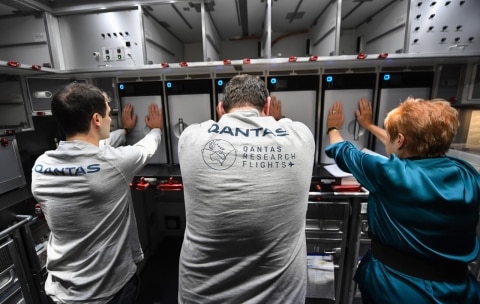What the Record-breaking Qantas Flight Can Tell Us About Jet Lag

Jet lag, the enemy of the international traveller, could be exacerbated by in-flight and post-flight behaviour, according to new research by Qantas and the University of Sydney’s Charles Perkins Centre.
The study of almost 500 passengers on Qantas international flights longer than nine hours has provided some valuable insight into how passengers handle ultra long-haul flying – and new ways to help overcome jet-lag.
So, how are we travelling? According to the initial findings from the study, 54 per cent of people surveyed use earplugs or noise cancelling headphones.

Some people avoid alcohol altogether – 24 per cent – but 38 per cent drink to help them get to sleep. A further 10 per cent use sleeping tablets.
Once they landed, 39 per cent of passengers chose healthy food to help them recover from the flight, and almost half made a point to spend some time in the sunlight – a proven method to help with jet-lag and re-set the body-clock.
Using the knowledge gained from the research, Qantas has devised new in-flight strategies to encourage wellness and reduce jet-lag upon landing.
These methods are already being tested. Qantas is running three ultra long-haul flights, known as Project Sunrise, the proto-flights are also being used to conduct studies on crew and passengers.
On Qantas's record-breaking Sydney to New York on 18 October, which landed after 19 hours and 16 minutes in the air, each of the passengers – just 49 people including crew – were fitted with wearable technology devices to monitor sleep patterns, food and drink consumption, lighting, physical movement and in-flight entertainment.
The study informed the menu, the timing of meals, cabin lighting and temperature of this flight. Passengers had to follow specially designed sleep, food and drink and physical movement schedules designed with the input of researchers from the Cooperative Research Centre for Alertness, Safety and Productivity.

Two more research flights are planned as part of Project Sunrise this year: London to Sydney in November and another New York to Sydney leg in December.
Qantas CEO Alan Joyce says these new in-flight studies will help make ultra long-haul flights more enjoyable.
“A lot of what we’ll be doing is world-first,” he says.
“The passenger research will test alternatives to how airlines have managed inflight service for decades. Usually with night flights, passengers are provided with dinner shortly after take-off and then lights are turned off. But this may not necessarily be the best way to help reset a passenger’s body clock to the destination time zone.”
Among the strategies already being put into effect: for passengers on Qantas’s longest journey, the Perth to London flight, there’s light therapy at the passenger lounges to help guests acclimatise to the new time zone; an outdoor area encourages guests to step outside to soak up some vitamin D; and a Wellness Studio in the lounge where guests can take stretching classes.
SEE ALSO: How to Trick Your Body-Clock and Beat Jet-Lag
Image credit: James D Morgan/Qantas


